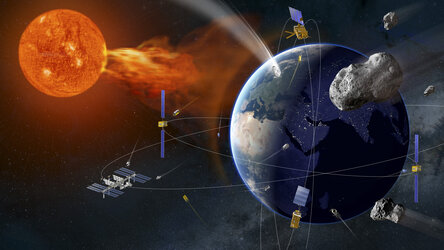N° 24–1999: Another windfall discovery from SOHO
22 June 1999
SOHO shows us the far side of the sun!
A truly astounding discovery about our sun is to be unveiled by a European team of scientists headed by Jean Loup Bertaux, of the CNRS Service d'Aronomie in France, when he reports to the SOHO-8* workshop in Paris (22 to 25 June). They have found a way of studying the hidden far side of the sun, allowing us, among other things, to predict the imminent appearance of solar storms originating out of view behind the sun.
Bertaux will present a compelling video sequence based on images captured by SOHO using an instrument called SWAN. It shows how projections of sunspots on the far side of the sun rotate through the sky in time with the sun's own rotation, ultimately emerging on the eastern (left-hand) side of its visible surface. This intriguing discovery could be used to predict the solar storms that periodically threaten the Earth.
"Strong ultraviolet emissions from active regions at the back of the sun behave like the beams of a lighthouse sweeping over the sea", explains Bertaux, who is Principal Investigator for SWAN. "The 'beams' rotate through the sky with the sun," taking approximately 28 days to complete one cycle, "and allow us to monitor activity on the far side of the sun without observing it directly. This method could be used in future studies on space weather, which is capable of disrupting orbiting satellites and earth-based electronics."
"SOHO has allowed us to study the sun extensively, from its interior to the space surrounding it. It is fascinating to think that now we can detect what's coming at us from the other side of the sun", says Martin Huber, Head of ESA's Space Science Department.
SOHO sees the shadow cast in space by a passing comet
SWAN (short for Solar Wind ANisotropies) was designed to create an ultraviolet map of the entire sky. It has chalked up another first by recording the biggest shadow ever observed in our solar system: the shadow of a passing comet.
Although most of the hydrogen atoms in the solar system blow in from interstellar space, comets are surrounded by large hydrogen clouds of their own. When comet Hale-Bopp blazed past the sun in 1997, sporting a tail 100 million kilometres in length, SOHO was on duty in orbit. Scientists studying the data recorded by SWAN have now detected a remarkable, hitherto unknown feature: the comet cast a shadow more than 150 million km long on the sky behind it.
"This allows us to calculate directly the amount of hydrogen and water released by the comet, about 300 tonnes per second," says Jean Loup Bertaux.
Roger Bonnet, Director of ESA's Scientific Programme, expressed his appreciation for the SOHO results: "After many years, SOHO is still at work and fully operational. As in the case of the comet's shadow, it keeps making discoveries and amazing observations."
Says Bernhard Fleck, SOHO Project Scientist for ESA: "The nice thing about this discovery is that with SOHO we're not just confined to studying the sun. Here we are contributing to a different and intriguing field. We are learning more about comets and their physics."
Note for editors:
The Solar and Heliospheric Observatory (SOHO) is a project of international cooperation between ESA and NASA. The spacecraft was launched by an Atlas rocket from Cape Canaveral on 2 December 1995.
More information can be found on the SOHO website at: http://sohowww.estec.esa.nl
Images of the far side of the sun and the comet's shadow are available at:http://sci.esa.int/soho
For more information, please contact:
ESA Public Relations Division
Tel: +33(0)1.53.69.7155
Fax: +33(0)1.53.69.7690
Jean-Loup Bertaux
Service d'Aéonomie du CNRS
BP 3
91371-Verrires le Buisson Cedex, France
Tel: +33(0)1.64.47.42.51
e-mail:bertaux@aerov.jussieu.fr
Bernhard Fleck
ESA SOHO Project Scientist
NASA/Goddard Space Flight Center
Greenbelt, MD 20771, USA
Tel: ++1 (301) 286-4098
e-mail:bfleck@esa.nascom.nasa.gov
The SOHO-8 meeting is the eighth in a series of SOHO workshops. It will be held in Paris (CAP 15, 1-13, Quai de Grenelle, 75015-PARIS) from 22 to 25 June 1999. Over 200 scientists from around the world will discuss their findings on the dynamics and diagnostics of the solar transition region and corona.















 Germany
Germany
 Austria
Austria
 Belgium
Belgium
 Denmark
Denmark
 Spain
Spain
 Estonia
Estonia
 Finland
Finland
 France
France
 Greece
Greece
 Hungary
Hungary
 Ireland
Ireland
 Italy
Italy
 Luxembourg
Luxembourg
 Norway
Norway
 The Netherlands
The Netherlands
 Poland
Poland
 Portugal
Portugal
 Czechia
Czechia
 Romania
Romania
 United Kingdom
United Kingdom
 Slovenia
Slovenia
 Sweden
Sweden
 Switzerland
Switzerland
























